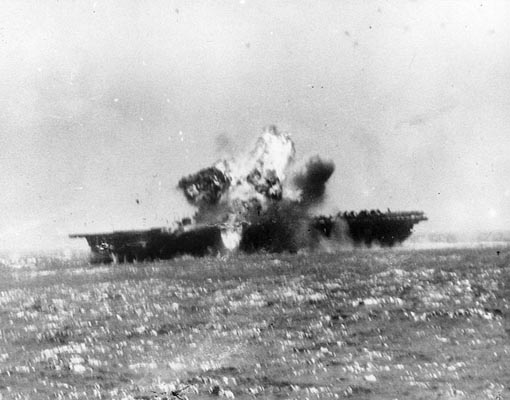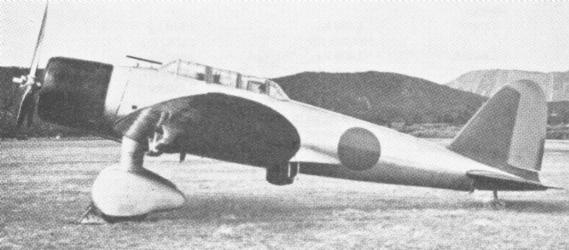It is not uncommon in warfare for a wounded soldier to "Take one with him." The most dramatic is that of a pilot on either side with a damaged plane with no hope of getting home to ram the enemy, either in the air, on the ground, or at sea.
- 19 June 44. Japanese carrier-based aircraft attack Fifth Fleet (Spruance) covering Saipan operation; battleship Indiana (BB-58) is damaged by suicide plane.
- 14 October 44. Japanese aerial counterattacks continue on TF 38, inflicting damage on light cruiser Reno (CL-96) by a suicide plane.

Late in the war, the Japanese established a policy of intentional suicide, called "special attack". From 24 October 1944, the policy of suicide attack inflicted much damage on the US fleet.
Kamikaze -- Japanese Navy suicide plane. The Army also used suicide planes.

- 21 Oct 44 Two planes with volunteers flew from the Philippines to attack US carriers.
- 23-26 Oct 44. Off Leyte, 55 Kamikaze pilots, in the first planned mass suicide attacks of the war, coordinated with the IJN attack on Leyte Gulf, hit the escort carriers and sank the St. Lo (CVE-63) and damaged the large escorts Sangamon (CVE-26), Suwannee (CVE-27), Santee (CVE-29), and small escorts White Plains, Kalinin Bay, and Kitkun Bay. In all, 7 carriers were hit and 40 other types damaged; five ships were sunk, 23 heavily damaged, and 12 moderate damage.
- 25 Mar 45-21 Jun 45. Off Okinawa -- Ten "Kikusui", swarms of Kamikaze, up to 350 attackers at a time, 1,900 in total, damaged 250 ships with 34 destroyers and smaller ships sunk. Several ships were damaged so badly they were not repaired. One in seven of all naval causalities occurred off Okinawa.
3,500 naval planes and an additional 1,500 army planes are hidden on Kyushu for the "final battle" and just as many for orthodox use; once suicide planes were used up, the orthodox pilots would become Kamikazes. This is a number sufficient to sink or damage 1,000 ships of an invading fleet.
Nakajima Ki-115. -- Specially built, basic aircraft that could carry a bomb used for kamikaze attacks. There were 104 build before the war ended, but had not yet reached combat units.
Mitsubishi J8M/Ki-200 Shusui -- rocket powered interceptor.
Japanese copy of German Me163 rocket powered interceptor fighter specially designed for use against B-29. The prototype flew on 7July45. The War ended before production.

Reppu. -- Specially designed kamikaze for use against B-29; the war ended before production.
Yokosuka Ohka. -- A piloted glide bomb, called "Baka" by the allies. The Baka piloted glide bomb was carried to within 12 miles of the target by a medium bomber. It would glide towards the target then activate rockets (model 11) or jet engine (model 22) to dive into the target and explode its one ton warhead. The Baka was difficult to stop, but its mother plane was extremely vulnerable.
- 21 Mar 45. Japanese make first known operational use of Baka piloted bombs in unsuccessful air attack against TF-58.
- 12 Apr 45. Off Okinawa, destroyer Mannert L. Abele (DD-733) is sunk by Baka--she is the first U.S. Navy ship to be sunk by that type of weapon. Destroyer Stanly (DD-478) is damaged by Baka. High speed minesweeper Jeffers (DMS-27) is damaged by Baka and kamikaze.
- 4 May 45. Light minelayer Shea (DM-30) is damaged by a Baka. Minesweeper Gayety (AM-239) is damaged by near-misses of kamikaze and Baka.
- 10 May 45 --In a crash program to counter the Japanese Baka (suicide) bomb, the Navy authorized development of Little Joe, a ship-to-air guided missile powered with a standard JATO unit.
- 11 May 45. Destroyer Hugh W. Hadley (DD-774) is damaged by Baka.

Ki-167 or Hiruy To-Go -- Bomber with 3 ton thermite bomb.
A Ki-67 Kai (Peggy) twin-engine bomber with guns removed and faired over, with crew reduced to four men, a 6,400 pound thermite bomb was installed with a blast radius of 1 km. Two are known to have been built, one sortied 17Apr45 for the USN fleet and disappeared, likely shot down by a Hellcat.
Shinyo -- Motorboat with two tons of explosives in the bow.
Great numbers were built and stored in caves for the invasion. 400 were at Okinawa; thousands waited in the coves of Japan proper. The speedboat had one man and, typically, two depth charges as explosives.
- 10 Jan 45. LCI(G)-365 and LCI(M)-974 sunk by Japanese suicide boats in Lingayen Gulf, Luzon, Philippines.
- 31 Jan 45. PC-1129 sunk by Japanese suicide boat off Nasugbu, Luzon, Philippine Islands.
- 16 Feb 45. LCS(L)-7, LCS(L)-26, and LCS(L)-49 sunk by suicide boats off Mariveles, Corregidor Channel, Luzon.
- 4 April 45. USS LCI(G)-82 and LSM-12 sunk by Japanese suicide boats off Okinawa.
- 27 April 45. USS Hutchins (DD-476) seriously damaged by a Japanese suicide boat in Buckner Bay, Okinawa, and not repaired after the end of the war.
Fukuryu -- Human mine - Swimmers carry an explosive charge beneath a ship.
- 8 Jan 45. Infantry landing craft (gunboat) LCI(G)-404 is damaged by suicide swimmers, Yoo Passage, Palaus.
- 10 Feb 45. Japanese suicide swimmers attempt attack upon surveying ship Hydrographer (AGS-2) in Schonian Harbor, Palaus.
Nikaku (spelling?) -- Human anti-tank mine - Soldiers with explosives strapped to their bodies.
The army had developed the technique in Philippines and on Okinawa to attack tanks by strapping explosive on a soldier who would crawl between the treads.

Kaiten -- Submarine launched, human guided torpedo.
48 feet, 3 feet diameter, 8.3 tons, 3,400 pound TNT warhead.
- 24 Jan 45. Begin Operation KONGO, employing suicide torpedoes [Kaitens]. I-36 launches Kaitens that damage ammunition ship Mazama (AE-9) and infantry landing craft LCI-600 at Ulithi.
- 12 Jan 45. Operation KONGO continues; submarine I-47 launches Kaitens that damage U.S. freighter Pontus H. Ross off Hollandia, New Guinea.
- 20 Jan 45. Operation KONGO concludes with Japanese submarine I-48 carrying out unsuccessful Kaiten attack on U.S. shipping at Ulithi. I-48 is sunk by destroyer escorts 23Jan45.
- 28 Mar 45. Japanese submarine I-47 (equipped with Kaitens) is damaged by 5th Fleet surface ships/craft off Okinawa and forced to return to Kure for repairs.
- From 26 Apr 45 to 10 Aug 45, ten ships were reported sunk.

Other Kaiten contacts include:
- 6 May 45. Submarine I-366, en route to take delivery of Kaitens, is damaged by mine off Hikari.
- 27 May 45. Destroyer escort Gilligan (DE-508) is damaged by dud torpedo Kaiten launched from Japanese submarine I-367.
- 28 June 45. Japanese submarine I-36 carries out unsuccessful Kaiten attack on stores ship Antares (AKS-3) southeast of the Marianas, destroyer Sproston (DD-577) comes to Antares's aid, sinking one Kaiten and damaging I-36.
- 24 July 45. Destroyer escort Underhill (DE-682), destroyed while intercepting 4 Kaitens from Japanese submarine I-53 off Luzon.
- 5 Aug 45. Destroyer escort Earl V. Johnson (DE-702) is damaged by explosion--near-miss of Kaiten fired by submarine I-53, Philippine Sea.
- 9 Aug 45. Destroyer escort Johnnie Hutchins (DE-360) on the convoy route between Leyte and Okinawa, sinks what may have been Kaitens launched by I-58.
- 12 Aug 45. Japanese submarine I-58 conducts unsuccessful Kaiten attack on dock landing ship Oak Hill (LSD-7) while she is en route from Okinawa to Leyte Gulf.
A shore based Kaiten station was established on the SE tip of Kyushu in prepartion for the invasion.
Koryu -- midget submarines.
Although not intended as a suicide weapon, survival rates were not high.
All five in the "Special Attack Unit" used in the sneak attack on Pearl Harbor were destroyed. Midgets also attacked in Sydney (all four lost) and Madagascar in June'42.
Five hundred 5-man submarines were being built for coastal defense with 115 completed at the time of surrender.
Additional Sources:
users.pandora.be
www.ww2pacific.com
www.usskidd.com
www.history.navy.mil
www.microworks.net
www.usslexington.bizland.com
www.spiegel.de
www.e-scoala.ro
koti.mbnet.fi
www.airgroup4.com
www.210521-journal.de
www.mlcook.lib.oh.us
www.katy.isd.tenet.edu
www.spclevents.com



